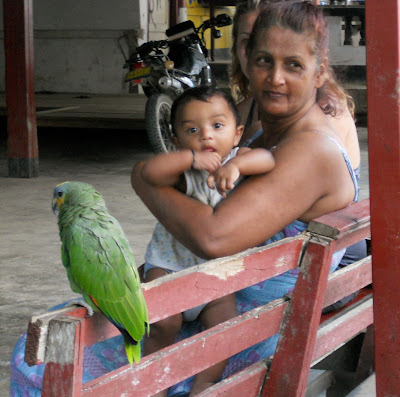 |
| Inquisitive little girl celebrating Holi in Suriname. |
One of the highlights of our Suriname trip was the fact that we were able to celebrate the Hindu Holi festival ("the Festival of Colors") with the Surinamese people and other travelers. Holi (or "Phagwa"), a spring festival, is celebrated at the end of the winter season on the last full moon day of the lunar month
Phalguna (February/March), (Phalgun
Purnima), which usually falls in the later part of February or March. Celebrations typically last for 2 days, and a major activity on the main day ("Dhuli") is the throwing of scented, colored powders on each other.
It might confuse the reader as to why we would be in a South American country, where Dutch is the official language, celebrating a Hindu holiday. This is one of the things that makes Suriname so unique! Due to the abolishment of slavery, workers were needed in the New World...this brought indentured servants from India, Indonesia, China and many other lands. Those immigrants, along with former slaves ("maroons"), joined the indigenous Amazonian Indian tribes and Dutch to make up the melting pot of Suriname. Dhuli is a national holiday, with all businesses closing, and
everyone joins in the fun.
Here is what
Wikipedia has to say about Holi:
"One of Holi’s biggest customs is the loosening strictness of social structures, which normally include age, sex, status, and caste. Holi closes the wide gaps between social classes and brings Hindus together. Together, the rich and poor, women and men, enjoy each other’s presence on this joyous day. Additionally, Holi lowers the strictness of social norms. No one expects polite behavior; as a result, the atmosphere is filled with excitement and joy.
Every year, thousands of Hindus participate in the festival Holi. The festival has many purposes. First and foremost, it celebrates the beginning of the new season, spring. It also has a religious purpose, commemorating many events that are present in Hindu mythology. Although it is the least religious holiday, it is probably one of the most exhilarating ones in existence. During this event, participants hold a bonfire, throw colored powder at each other, and celebrate wildly.
Originally, it was a festival that commemorated good harvests and the fertile land. In addition to celebrating the coming of spring, Holi has even greater purposes. Hindus believe it is a time of enjoying spring's abundant colors and saying farewell to winter. Furthermore, Holi celebrates many religious myths and legends."
To prepare for our observation of the Phagwa festivities, we first had to find out where the parties would be held. You won't find them at the Hindu temples -- those are sacred places, where the Holi revelry would be inappropriate. In speaking with an Indian lady and perusing the local newspaper, we learned that the biggest party in town was being hosted by Parbo Bier, and would be held at Flamboyant Park. So, with some Phagwa powder and baby wipes in hand, we set off by taxi to the site. (Note: we had been advised that if we were too much of "a mess" after the party, taxi drivers might refuse to bring us back to our hotel. We prepared for this by buying some cheap rain ponchos!)
Upon our arrival at the event (admission: Free!), we were anointed with Phagwa powder by gate attendants, who gave us each a container of the color of our choice. Blue for Tom, yellow for me, to add to the pink we had already brought. We watched as large tanker trucks pumped water into inflatable swimming pools, to which various colored dyes were then added. A large number of water guns were stacked up, and they were quickly filled with colored water and put to use by merry makers young and old!
For those who preferred to stay dry, being sprinkled with the colored powders by strangers and listening to music was the order of the day. There was, of course, Parbo Bier and Coca-Cola for sale, and Indian food (we had bami goreng - Indonesian stir fried noodles - and spicy chicken), and more than one group of revelers managed to smuggle in bottles of the hard liquor of their choice. Tom and I "made the rounds", meeting all sorts of people, including Surinamese of every origin, Dutch students, U.S. Coast Guard officers who just happened to be in town, young, old and in-between.
By the end of the day, we were blue, pink, green, yellow and orange...and smiling from ear to ear. And to top it off, we were able to find a taxi willing to take us back to town!
 |
| Music is a major part of the Phagwa Party |
 |
| Having fun with Phagwa powder (gulal) and water! |
|
 |
| There's always a yellow one in the group! |
 |
| How can you keep a straight face when your hair is blue? |
 |
| We met these U.S. Coast Guard officers visiting Suriname and ready for the festivities. |
 |
| Young artist hard at work. |
 |
| The dance floor is the place to be. |
 |
| Thrilled to be here! |
|
 |
| How we looked by the end of the day!! |
|






























